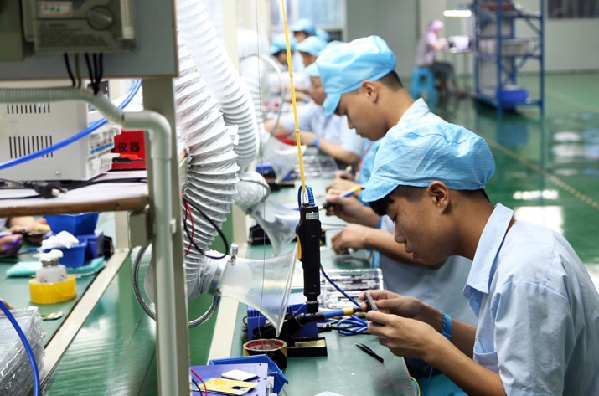Is 'Made in China' bust?
- By Mei Xinyu
 0 Comment(s)
0 Comment(s) Print
Print E-mail Beijing Review, March 3, 2016
E-mail Beijing Review, March 3, 2016
|
|
|
Workers produce mobile phone components at a plant in Huaying, southwest China’s Sichuan Province, on July 22, 2015 (XINHUA) |
China is facing challenges in its economic horizon. The sharp fluctuations of its stock and foreign exchange markets in January have cast a gloomy light on its financial situation, and George Soros' prediction of a China crash has aggravated the predicament. Top priority should therefore be given to stabilize the financial market as well as rectify investors' misinterpretations. China's manufacturing industry is even more misunderstood than its financial market. Quite a few market participants and spectators have greatly underestimated the adaptability of China's manufacturing industry and its capacity to absorb shocks. That has shaken their confidence in the stability and growth potential of China's financial system and macro economy.
Transition period
Indeed, the "Made in China" concept, which has underpinned China's economy for decades, is undergoing a difficult transition period as it goes through the throes of capacity reduction. On one hand, some labor-intensive manufacturing industries, say textile and garment for example, have moved their production bases to other developing countries where labor costs are lower. This has caused an estimated 3-percentage-point dip in Chinese-made products' share of the U.S. textile and garment market. On the other hand, the rise of "Industry 4.0," put forward by Germany, may herald the bankruptcy of Made in China in the eyes of some people, since Industry 4.0 aims to increase productivity through the use of automation and information technology.
Rumors that China's manufacturing industry will experience all-encompassing failure have spread like a wildfire. The current overcapacity of traditional sectors such as building materials, and iron and steel, are deemed as the beginning of the end of China's manufacturing boom, and even its economy.
Does that reflect the actual situation, though? From the perspective of people who have carried out long-term investigations and know more about the true state of China's manufacturing industry, the answer is no. As a matter of fact, what China's manufacturing is undergoing is not a crash, but a disruptive yet simultaneously creative period.
While some traditional industries face pressures to cut overcapacity, competent enterprises have begun to stand out and new emerging industries are also sprouting. In 2015, hi-tech industries' value-added output, which accounted for 11.8 percent of the total industrial value-added output in that year, went up by 10.2 percent, which was higher than the 6.1-percent growth of the entire industry. Last year, investment in coal mining and iron and steel witnessed a slump of more than 14 percent and 11 percent respectively. In contrast, investment in the computer, electronics and telecommunication equipment manufacturing and pharmaceutical industry climbed 13.3 percent and 12 percent, respectively. Even in traditional industries that have been dragged down by overcapacity, competent enterprises have come on top by cutting excess capacity.
The Industry 4.0 movement will give incentive for the proponents of Made in China to turn a new leaf, rather than diving into all-encompassing failure. Since 1978, when the reform and opening-up policies were adopted, many manufacturing sectors have been hit by several rounds of technological improvements. Despite temporary hardships, the whole manufacturing industry has always benefited from significant technological progress and an expanding market share. While companies that fixed their eyes on short-term profits are eliminated, forward-looking, persevering and steadfast manufacturers will survive. Why are we anxious about such a "crash"? Historical experience and reality have given us good reasons to believe in Made in China.






